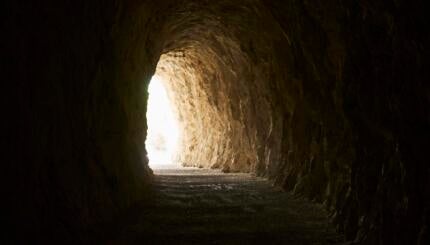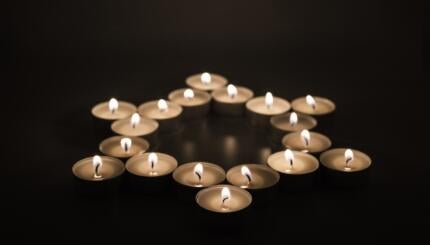Years ago, I was driving with a dear friend and her father at night on a dark road in rural Nebraska when the car stopped and we got out to admire the most magnificent river of stars. I was stunned. I had never really seen the Milky Way, not like that. Now I live in New York City, but whenever I get a chance to experience sacred darkness, I take it.
In Jewish sources, darkness is often opposed to light, and even sometimes depicted as the embodiment of evil or death. Consider this well-known line from Psalm 23: “Even though I walk through the valley of the shadow of death, I shall fear no evil.” When God first creates light, God sees that the light is good, but no such declaration is made about darkness. The Jewish mystical tradition associates light with chesed (love) and darkness with gevurah (restriction, limitation or even evil). When the songwriter Leonard Cohen says to God, “You want it darker,” in his song of the same name, he seems to mean that God dwells in a morally compromised world.
But in the Bible, darkness is also associated with profound manifestations of divine presence. In the second verse of Genesis, we see darkness in close proximity to the divine: “darkness was on the face of the deep, and a wind of God hovered on the face of the waters.” Here, darkness does not seem to embody evil or suffering, but rather the potential that exists before God’s creative process begins. Darkness isn’t evil, or even chaotic: It’s the raw material of worldmaking. It’s God’s partner in beginning to create.
But the Bible goes even further, portraying darkness not only as a kind of potentiality, but also as a sign of God’s presence. Deuteronomy 4:11 states that at Mount Sinai, God speaks out of “darkness, cloud, and arafel.” (The phrasing is slightly different in the next chapter, which states that God’s voice emerged from fire, cloud and arafel.) Arafel is a Hebrew word that connotes some kind of fog, thick cloud or intense darkness. It’s related to the word araf, which means to drip, as in a raincloud. This thick darkness, according to the text, accompanies the revelation of the Torah. There’s lightning, yes, but there’s also cloud. Darkness here evokes feelings of awe, mystery and wonder.
With your help, My Jewish Learning can provide endless opportunities for learning, connection and discovery.
This sacred darkness, this fog of mystery, appears in the Temple too. In I Kings 8:12, as King Solomon dedicates the Temple, he recites a poem that proclaims: “God has promised to dwell in the arafel.” In a similar vein, Psalms 97 says that God is surrounded by cloud and arafel. Here, the arafel, or darkness-cloud, is synonymous with the kevod Adonai, the thick presence of the Divine. While God’s presence may be indicated by a pillar of fire, the pillar of cloud is just as important.
In her essay “To Dwell in Thick Darkness: The Sacred Dark in Jewish Thought,” Rabbi Fern Feldman writes that “darkness is the place where all separation dissolves into oneness.” Perhaps this is why darkness has this double edge in our tradition, embodying both what scares us — losing ourselves — but also what heals us: letting go into a reality that is larger than we are. Feldman also notes that darkness opens us to mystical states, which may be why our ancestors associated darkness with moments of profound revelation. Rabbi Levi Yitzchak of Berdichev, who wrote the Hasidic commentary called the Kedushat Levi, in describing the plague of darkness that fell upon Egypt, speaks of the hoshech shel ma’alah, the heavenly darkness. It seems to me this heavenly darkness is a huge gift.
Twice in my life I’ve been inside a cloud — once on Mount Marcy in the Adirondacks, and once at Lake Mohonk. Both times, it was a wondrous experience. The mist softened the edges of everything, so that every object seemed somewhat veiled, creating a dance between the hidden and the revealed. In this mysterious landscape, anything — a pebble, a tree, a pathway — could appear magical. Perhaps this softening of edges is exactly what allows us to experience our individual selves as a little less stark and separate, and a little more open to mystery.
For many of us, this year has been one of darkness in the initial sense I described above —a season of unknowing, profound uncertainty, sorrow, fear and anxiety. But darkness doesn’t have to be a metaphor for our fears. It can equally stand for potential and creativity, a nebula from which new stars can be born. Darkness can be the sacred space we go to when we pray or meditate, and the cauldron from which we draw our creativity. Perhaps in this intense time, we can embrace the sacred darkness, which offers us a different kind of knowing, without certainty, but with the potential for deep wisdom. As the calendar takes a turn toward the winter solstice and the nights grow longer, I hope we find ways to use the gifts that darkness brings us: creativity, humility in the not-knowing, wonder and attention to the mysteries of existence.
This article initially appeared in My Jewish Learning’s Shabbat newsletter Recharge on November 16, 2024. To sign up to receive Recharge each week in your inbox, click here.



